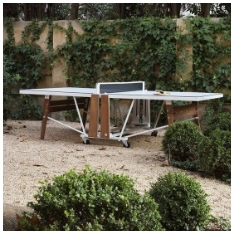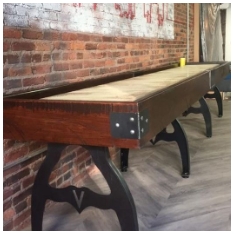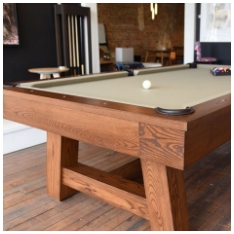Choosing a pool table involves more than selecting a style or brand. The size of the table must fit your room while allowing enough space to play comfortably. This guide walks through how to choose the right pool table size for your space, including measurements, room layouts, cue lengths, and practical considerations for home setups.
Understanding Standard Pool Table Sizes
Pool tables are available in several standard sizes. The most common include:
7-Foot Pool Tables (Bar Size)
Often found in bars and recreational rooms, 7-foot tables measure approximately 39" x 78" for the playing surface. They require less space and are suitable for more compact home game rooms.
8-Foot Pool Tables (Tournament Size)
This is the most popular home pool table size. The playing surface measures around 44" x 88". It strikes a balance between casual play and competitive quality.
9-Foot Pool Tables (Professional Size)
Used in professional tournaments, 9-foot tables have a playing area of about 50" x 100". These require significantly more room and are best suited for dedicated game rooms with ample space.

Calculating Room Size Requirements
Before selecting a pool table, calculate the total space needed. It’s essential to include cue clearance around all sides of the table.
Cue Length Considerations
Standard pool cues are 58 inches long. To calculate room size, add twice the cue length to the table’s playing dimensions.
For example:
- A 7-foot table (39" x 78") + (58" x 2) = Approx. 13' x 16'
- An 8-foot table (44" x 88") + (58" x 2) = Approx. 13.5' x 17'
- A 9-foot table (50" x 100") + (58" x 2) = Approx. 14' x 18'
You’ll need additional space if you plan to use longer cues or have limited freedom of movement due to walls or furniture.
Room Shape and Layout Considerations
Not every space is square or perfectly rectangular. Angled walls, doorways, columns, and windows can impact how a pool table fits.
Measure the Entire Usable Area
Use a measuring tape to assess the full playable area, accounting for door swings and walkways.
Consider Furniture Placement
Avoid placing furniture or shelving too close to the playing zone. Even if the table fits, cluttered surroundings will limit cue movement.
Lighting and Ceiling Height
Proper lighting is important for visibility. Ensure the ceiling is high enough to install lighting directly above the table without obstruction.
Adapting for Smaller Spaces
If your room is slightly smaller than recommended, there are ways to adjust.
Use Shorter Cues
Shorter cues (36” or 48”) help in tight corners or when the cue hits walls. This minor adjustment can make a standard-size table workable in a smaller room.
Opt for a 7-Foot Table
When space is tight, a 7-foot table may be more appropriate. It allows for relaxed play without overcrowding the room.
Multi-Purpose Tables
Some manufacturers offer pool tables that double as dining or conference tables. This helps save space while maintaining functionality.
Flooring and Surface Considerations
The pool table must sit level to ensure fair play. The type of flooring impacts both stability and longevity.
Floor Strength
Pool tables are heavy, often weighing 700–1,000 lbs. Ensure your flooring is reinforced enough to support the weight, especially on upper floors.
Level Surface
The surface must be perfectly level. Floors with uneven tiles or sloped corners will affect play. Use leveling tools during installation.
Protecting the Floor
Place mats or rubber feet beneath the table legs to prevent dents or scratches on hardwood or laminate floors.
Planning for Delivery and Installation
A pool table’s size also affects how easily it can be delivered and assembled inside your space.
Check Access Points
Measure doorways, hallways, and staircases. Ensure the table can be brought inside without damage or obstruction.
Professional Installation
Hiring a professional is recommended. Pool tables must be carefully leveled, and slate surfaces properly aligned. An experienced installer will manage these tasks efficiently.
Common Mistakes to Avoid
When buying a pool table, overlooking certain space or design elements can lead to costly corrections.
Buying Without Measuring
Never estimate space. Use a tape measure and floor plan sketch to visualize the setup before purchasing.
Ignoring Cue Clearance
The table might fit, but without cue clearance, gameplay suffers. Always add at least five feet around the playing surface.
Overlooking Room Function
If the room is used for other purposes—such as a family room or office—consider whether the pool table will interrupt daily use.
Practical Examples by Room Type
Understanding how tables fit into common room types helps with planning.
Basement Game Rooms
Basements typically offer privacy and space. Make sure ceiling height allows for cue movement and lighting.
Living Rooms
If using part of a living room, opt for a multi-use table or smaller size. Match the table finish to surrounding décor for a cohesive look.
Garages
Garages can be converted into game rooms. Insulate the space properly and level the floor to prevent warping or table shifting due to temperature changes.
Final Tips on Choosing the Right Table
- Sketch your room with exact dimensions
- Use painter’s tape on the floor to mark where the table and cue space would be
- Consider future uses of the room before finalizing the purchase
- Talk to professionals about customization options suited to your space
Conclusion
Choosing the right pool table size is a matter of precise measurement, room layout, and thoughtful planning. By understanding table dimensions, cue clearance needs, and adapting to your home environment, you can select a table that fits comfortably and enhances your game experience. Whether you're furnishing a dedicated game room or making use of a shared space, the right preparation ensures you enjoy every frame without compromise.





